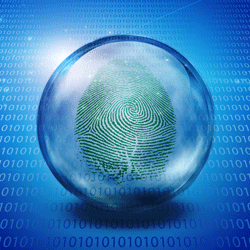 |
| “Soft” biometric measurements, such as gait, gender, and ethnicity offer new possibility for biometric solutions |
Analysing information obtained at a distance based on captured surveillance video can also supplement other biometrics and make them more effective. Identifying a person's gait or gender might help to narrow the range of possible matches and speed up a “one-to-many” match. If a human can be spotted at a distance of 500 meters (about 1,600 feet), a biometric system could start monitoring and capturing information about posture, height, weight, etc. and eliminate possible matches as the subject approaches. Closer to the camera, a match might be possible from a lower-quality image because there are fewer identities being considered. Fusing information from multiple less-accurate biometrics, even if limited by image quality, can provide a match that would have been impossible given any of the measurements independently. Developing these types of systems is among the research projects under way at CITeR's various university sites.
Voice recognition (audio) has become a very effective means of identifying people, too, but how can you identify a speaker from a very short voice clip or telephone conversation? Can you identify them from a casual speech sequence, rather than requiring them to speak a certain phrase? Additional CITeR research is expanding the possibilities.
Research into multiple biometrics disciplines
West Virginia University in Morgantown, W.Va., is CITeR's founding site, focusing on biometrics, identification technology and systems. Clarkson University, Potsdam, N.Y., currently the managing site, focuses on biometric vulnerabilities and intelligence, while the University of Arizona, Tucson, Ariz., focuses on credibility assessment systems. The University at Buffalo (N.Y.) joined in 2013 and focuses on handwriting, cryptography and soft biometrics. Each CITeR university site maintains interdisciplinary and collaborative partnerships with other academic institutions to respond effectively to affiliate research needs.
Collaboration with the security industry
CITeR's affiliates include system integrators Lockheed Martin, Northrup Grumman, Raytheon and Morpho, and also companies active in the physical security market such as FLIR Systems, Honeywell and SAIC.
“Identifying a person's gait or gender might help to narrow the range of possible matches and speed up a “one-to-many” match” |
“We welcome all the companies in the security market that want to participate in pre-competitive research,” says Bojan Cukic, director of CITeR's West Virginia University's founding site. The centre's rules on intellectual property are spelled-out specifically, and any information can be used by the centre's affiliates royalty-free. All of them have equal access to the technology created there, and technical people from various companies visit the centre often to see the direction of research and its potential. The Center's Advisory Board meets twice a year to review results and direction of current work by the centre. Private companies will build on the basic research to create products that will provide them a competitive advantage. The products might come two to five years after the basic research is complete.
“We are the only multi-university centre in the United States creating this type of research collaboration,” says Cukic. “We are designed to be a National Science Foundation (NSF) cooperative research centre, based on the model of collaboration between industry and universities that NSF created 30 years ago. There are 60-plus centres like ours, but we are the only ones in identity management and biometrics.”
High volume of biometric data furthers research efforts
Another benefit of the centre is its collection of 5 to 7 terabytes of biometric data that it uses for research. The data trove includes a unique collection of twins and triplets and their parents, which can help the centre analyse the ability of technologies to differentiate among individuals whose biometric measurements may be similar or identical. The data also allows analysis of how individuals change in appearance over several years and the impact of those changes on biometric capability. The centre even studies DNA and how it affects the appearance of the face, which Cukic says “allows us to understand the breadth of the problem and identify the factors in face recognition that haven't been used before.”
Cukic emphasises that privacy protection is a strong component of CITeR research, and the centre is aware of Big Brother perceptions and realises that information stored over time could be used in unanticipated ways. However, concerns about the centre's work should be put into perspective, given the vast information Big Data is already compiling, says Cukic.
“Google, Yahoo or Facebook are tracking much more information about us than any surveillance system in a public place would ever be able to collect,” he says. In fact, privacy is one of the topics of research. For example, how could faces be blurred in video and then later clarified if there is a specific court order for information in the video? How can gender and age information be removed from finger and palm prints? The centre also provides technical advice to lawmakers and legislators as they consider human rights protections.
Discover how AI, biometrics, and analytics are transforming casino security













































